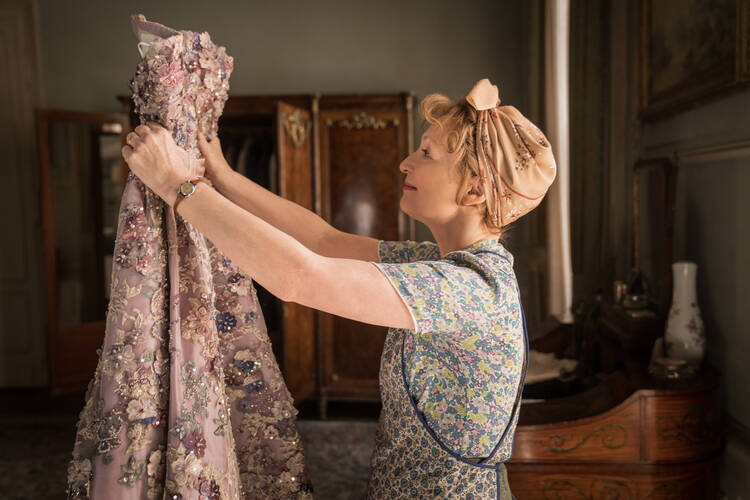This essay contains spoilers for “Mrs. Harris Goes to Paris.”
“Mrs. Harris Goes to Paris,” a new film based on the 1958 book of the same name by Paul Gallico (with her last name Britishly cut down to “Mrs. ‘Arris”), follows an English cleaning lady’s quest to buy a haute couture gown in the 1950s. Along the way, the film explores the pitfalls of materialism through characters who long for the elegance and glamor of designers like the renowned Christian Dior.
Mrs. Harris, played with elegance and charm by Lesley Manville, is a cleaning lady for wealthy families. Her quest begins when she discovers a lilac-colored strapless gown sitting on a chair while cleaning one of her employers’ homes. While the lady of the house holds the dress up to herself and gazes at her reflection in her mirror, she tells Mrs. Harris she got the dress because of the fabulous way it makes her feel.
‘Mrs. Harris Goes to Paris’ explores the pitfalls of materialism through characters who long for the elegance and glamor of designers like Christian Dior.
However, the matron never wears it. She puts the dress away in the closet, hiding it and its big price tag from her husband and from the world. So focused on her feelings and internal dilemmas, she never shares her dress with anyone. She puts her sparkling dress under a bushel.
Inspired by her encounter with the dress, Mrs. Harris flies to Paris. Though she is a busy worker and a penny pincher, she could not pay for the airfare and the dress she would subsequently buy all on her own. Brand names have high price tags. Mrs. Harris receives significant help from her departed husband’s pension, the kindness of others and sheer good luck, including a reward for returning to the police a fine piece of jewelry she found on the street.
But she does make it to Paris and attends Dior’s fashion show. Dior’s brand name was only 10 years old at the time the film was set, but his designs and perfumes were already popular and celebrated throughout Europe. He was awarded entrance into the French Legion of Honor for his contributions to the textile industry and fashion craftsmanship.
Mrs. Harris falls for a scarlet Dior dress named Temptation that another aristocratic wife purchases out of spite after seeing Mrs. Harris’s interest in it. Avarice would have been an equally good name for the dress. Mrs. Harris instead purchases an emerald green gown, but it needs a week of alterations before she can take it home to England.
Mrs. Harris knows the value of a dress and she uses the garment to help others, even when people do not deserve it.
In the haute couture workshop she takes the dress to (an ’atelier), Mrs. Harris announces she feels as if she has entered heaven. Sunlight and anonymous workers dressed in white fill a series of rooms; it takes them hundreds of hours of skilled labor to make a single dress. For Mrs. Harris, entering this kind of heaven does not mean leaving the workforce though. She soon finds herself sewing to help pay for unexpected expenses for her dress.
Mrs. Harris knows the value of a dress and she uses the garment to help others, even when people do not deserve it. After her adventure in Paris, she returns to England and goes back to work. Soon after arriving home, another of her employers, an aspiring movie star, comes to her complaining she has nothing to wear for a career-deciding event. The cleanest dress the starlet has is wrinkled, with a large stain on the front. Against her better judgment, Mrs. Harris lends her the brand new Dior. She doesn’t put her sparkling dress under a bushel, choosing instead to share its light.
At a lavish dinner that evening, the starlet accidently burns the skirt by an open fireplace. The next day, Mrs. Harris finds the damaged Dior laid out in the actress’ empty flat. Mrs. Harris gives the burned dress a burial at sea.
Mrs. Harris’ dream of Dior is then unexpectedly resurrected. The ‘atelier, after reading about the starlet’s disaster in a newspaper gossip column, is moved by Mrs. Harris’ compassion for others in need. Her good deeds, like a town on a hill, can’t be hidden. He sends her the scarlett dress, Temptation, that had been Mrs. Harris’ first choice at the fashion show. (It turned out that the spiteful aristocratic woman couldn’t pay for it.)
Unlike the aristocratic wife or the careless starlet, Mrs. Harris does not spend time admiring herself in the mirror. She gains satisfaction from her Dior gown by seeing the starlet wear it, and by the look on her friends’ faces when they see Mrs. Harris in her new dress. Her joy inherently involves others, and is dependent on their happiness too. The beauty of the dress is only a small part of her happiness, and in this way Mrs. Harris models how to enjoy a luxury good.
The film does not condemn Mrs. Harris’ quest for a sparkling red haute couture gown that, at the local dance in the film’s conclusion, stands out like a beautiful sanctuary lamp amidst dozens of dim votive candles. The film instead condemns people who are selfishly hiding objects for themselves, or carelessly hurting others’ feelings, not to mention mocking their belongings. The film rewards those who are hard-working and generous.
Ultimately, “Mrs. Harris Goes to Paris” does not suggest that viewers need to imitate her and start saving for a Dior dress. Mrs. Harris is only able to achieve her goal through others’ generosity and a great deal of luck. The real goal is using goods to uplift and appreciate people, actions which, like the joy she found in the workshop of Dior’s ‘atelier, bring Mrs. Harris a little closer to heaven.








